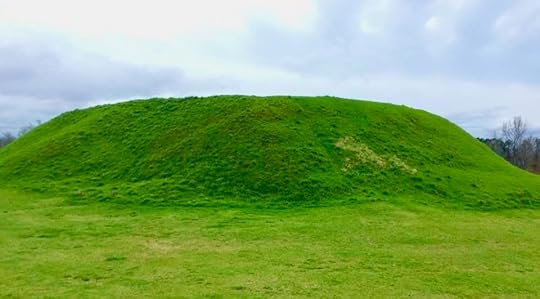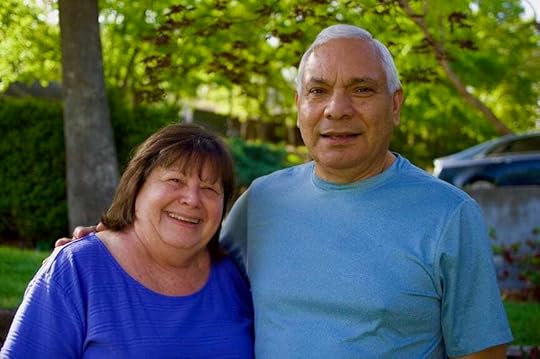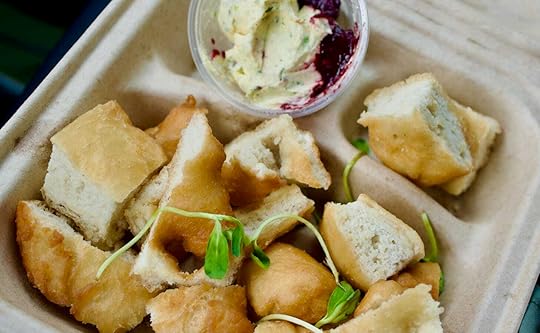One Way to Reclaim Ancestral Lands
WHEN I HAD the great fortune of interviewing Chief James Floyd, past Principal Chief of the Muscogee (Creek) Nation, I learned something that floored me.
Something I would have never guessed.
Something that makes all the sense in the world.
+
I live in Georgia, in the ancestral lands of the Muscogee (Creek) Nation. I wanted to talk about this connection with Chief Floyd, who lives in Oklahoma but has deep emotional and historical ties to the land where I live. He kindly agreed to an interview.
In the interview, which took place a couple of years ago, I got a deep look at how place affects humans inter-generationally and at the kinship that love of place affords.
+
My greatest takeaway was the realization that one way to reclaim a homeland is simply to buy it back.
 Ocmulgee Mounds National Historical Park, Macon, Georgia
Ocmulgee Mounds National Historical Park, Macon, Georgia+
As a writer, I have been working to support the decades-long efforts of the Muscogee (Creek) Nation, community leaders, and environmental activists to designate tribal homeland in middle Georgia as a true National Park. At the center of Ocmulgee National Park would be what is now known as Ocmulgee Mounds National Historical Park.
This would be the first National Park in Georgia.
You can read more about the movement for Ocmulgee National Park in my essay that appeared in The Bitter Southerner, “Getting a National Park in Central Georgia.”
Follow progress of the national park on Instagram at Ocmulgee_park_and_preserve.
+
My interview with the past Principal Chief became a chapter in an anthology, Wildlife Stewardship on Tribal Lands, edited by Serra J. Hoagland and Steven Albert, published by Johns Hopkins University Press. You can obtain a copy of the book here.
In this edition of Trackless Wild I present to you a portion of that interview. In case you have limited time, I have made bold a few important lines.
 Past Principal Chief of the Muscogee (Creek) Nation, James Floyd, and his wife, Carol, welcome me into their home in Tulsa, Oklahoma.Reclaiming Ancestral Lands and RelationshipsAn Interview with Chief James Floyd
Past Principal Chief of the Muscogee (Creek) Nation, James Floyd, and his wife, Carol, welcome me into their home in Tulsa, Oklahoma.Reclaiming Ancestral Lands and RelationshipsAn Interview with Chief James FloydRay: Chief Floyd, to get us started, would you talk about the Muscogee relationship to land along the Ocmulgee River in Georgia?
Chief Floyd: That was our original homeland. I can remember from the earliest times my parents teaching us who we were and where we came from, and that always had a deep meaning for me. It helped shape who I am and how my life has worked. What I believe—and I speak for a number of other tribal members—is that our past has taught us to be resilient to the present, and it will help us to be strong in the future if we only learn about our past and the significance of it. The things we have experienced, the history of our Tribe, a lot of that has been tough and sad and very hard to understand. If we could understand our history—of the families, of the places—and utilize that in our lives and in the government of our Tribe, then it makes us stronger. When we look at Ocmulgee, there’s a story there and a meaning there, and it’s for us to embrace that story, to learn as much as we can about it, and to use that to guide us in what we do.
Part of our tradition is that we really don’t revisit the past, particularly when it comes to the Trail of Tears. We had to pull up and leave the place that we loved, to come to a place that was foreign to us. When I was the Principal Chief, elders and traditional people in the Tribe would tell me, “We’re not supposed to talk about the past, and we’re not supposed to revisit or go back there.” At the same time, there is a growing interest from our members to know and understand our past. To be able to go back and touch it and be there is very meaningful to our people.
Wikipedia gets our history wrong. It can be put online and be completely different from reality. We’ve seen that. I’ve seen that personally. The knowledge we can gather can give us the strength we need to be able to tell our own story, and doing that strengthens us and makes us a fuller population of people that have the knowledge that we’ve gained from ourselves about ourselves.
Ray: I love that you used the word “touch.” That’s a verb that not many people would use, because you’re not using it in the normal sense.
Chief Floyd: Right. Our whole existence comes from the Earth and from the ground, and so it has a deep meaning to us. It’s very much about being attached. That’s one of the best things about going back, say to Ocmulgee. We’re able to be a part of what made us who we are now, to see it firsthand—the trees, the surroundings—and smell it and touch it. It’s a very real thing for us.
Ray: Ocmulgee Mounds was a vibrant, thriving, active place—a town, a community. Why did the Creek people leave? Where did they go?
Chief Floyd: One thing I don’t have the full answer for is what happened. But we do know that for over 600 years of consecutive time our ancestors lived there. That’s one of the strongest statements we can make, that we know we were there—100% documented—for 600 years. We can’t say that about other sites.
I’ve been reading about the period of the 1600s and 1700s. About the time of the revolution, 1776, we began to be a confederacy. We took in the Seminole, Yuchi, Coushatta, and some smaller tribes that had been in that area and that had been almost destroyed. We gave up life at Ocmulgee Mounds and became more dissipated throughout the Southeast, living in little communities. We still carried on the everyday practices and hierarchies. But we gave up mound building.
Ray: In Oklahoma there’s a city called Ocmulgee—the name means “boiling waters.” I thought that was so strange, that your people came from Ocmulgee in Georgia and named their new town “Ocmulgee.”
Chief Floyd: When we were forced to move to Oklahoma and relocated here, we kind of aligned ourselves similarly to how we were back east.
Ray: How old were you the first time you went back to Ocmulgee Old Fields?
Chief Floyd: It wasn’t until I was Chief that I actually set foot at Ocmulgee Mounds. It was a very comforting feeling back there the first time. You could see why we loved the area so much, why there was so strong an attachment there. It was so comforting. It was almost like you got to go back to that time when we were there. To have it preserved there at Ocmulgee was so unique, emotional, and powerful. It brought back memories, but it also brought to the surface feelings that I haven’t quite had in my life. It was like going back and being baptized in that era. Seeing how much it could mean and experiencing that firsthand strengthened me. I thought, “We’ve got to do something here. This is who we are, and we have to do all we can do to preserve it. Because it will be useful to us in the future.” Everything made sense. It was like a puzzle, and all the pieces fit together.
Ray: I hear you. It’s a little hard for me to understand it on a gut level, Chief Floyd. As a white person, maybe I’d have to go back a thousand years to get to my ancestral land, and I’ve never been to Great Britain. There must be a deep sense that you’re home.
Chief Floyd: Very much so. It’s a very comforting feeling. I’ve heard so many other people describe it that way. [They] go back there, and they say, “This is our home.” That’s why so many people go back, because it gives us so much satisfaction and strength. I cannot believe that it would do anything negative to us. It affirms everything we’ve been taught.
Ray: When I was visiting Brown’s Mount in Georgia, the activist John Wilson brought me up the back way. We kept climbing and finally pulled ourselves up some rocks, and we came upon a pestle, a hole in a rock, perhaps where grain was pounded.
Chief Floyd: I know the place, up on a hill. We stood at the edge of a cliff and looked at that. We have a responsibility to preserve and protect our past. If we don’t, no one will understand it, it will go by the wayside, and we will lose a significant piece of our history. I took several council members down there with me so they would understand it. So when land came available, it was a no-brainer for us to buy it. We needed to have it so we can preserve it and protect it. Maybe I won’t understand that in my entire life. We might at a later time learn more about the significance of that area.
Ray: Are you saying that you have purchased a tract of land in the area, that the Nation has bought back some of its ancestral homeland?
Chief Floyd: Yes. We purchased about 125 acres in 2019.
Ray: I’m floored and moved by that. Congratulations!
Chief Floyd: Thank you.
Ray: Have any decisions yet been made by the Nation about your property there or the entire Ocmulgee Old Fields?
Chief Floyd: Our main concentration effort is the corridor, in particular the subject of the National Park Service study, essentially a 50-mile range along the Ocmulgee River. Historically we lived and subsided and traded along that river route. As we purchased the land, we recognized nearby landowners, the Fish and Wildlife Service, the state of Georgia. We have neighbors who are good caretakers for the land. The study proposed multiple uses, including hunting, fishing, hiking, biking. We certainly don’t want to be the one that says, “Everyone but us.” When I was in office, our objective was to coexist with others. I would recommend a cooperative agreement in the future. We would want to be part of the bigger plan of the area, and that would be the approach I suggest we take.
Ray: As you know, there is a population of black bear in the Ocmulgee National Park study area. It’s one of only three populations left in Georgia. When you talk about recollecting your lives as tribal people, you talk about the animals that were traditionally part of the greater community.
Chief Floyd: Muscogee people were known for our clans—Raccoon Clan, Alligator Clan, Deer Clan. We get our clans from the maternal side of our family. My clan is Wind. My dad was Bear Clan. Those people revere those species. In a sense, through our own culture and history, we regulate ourselves in terms of wildlife, because even though I’m Wind Clan, I respect the Bear Clan as well.
By the same token, some aspects of animals are used in our ceremonies, like turtle shells are used by the ladies who lead the rhythm of some of our songs. When I grew up, we used the shells of dead turtles. You didn’t just kill something for the value of the shell. They lived their life, and you respected it. There are plenty of feathers laying out in the woods. I am not aware of any disrespect in this way, and I am hoping not because it goes against the morals we have.
Ray: Were people from different geographical locations associated with different clans?
Chief Floyd: Maybe at some point, but I think it’s mostly family. You need different clans to support a robust and diverse society. I have a book that lists the clans, and we had around 40. Presently we have 23 clans recognized. Some are extinct. Our fear is that more are becoming obsolete.
Ray: Does a line just run out?
Chief Floyd: In the same way you could lose a family name, you could lose your clan.
Ray: It would be so sad if an extinct clan were also an extinct animal.1 Bison existed in the Ocmulgee Old Fields when your people were there, and they’re gone now.
Chief Floyd: Also eastern elk. But I’m not aware of an Elk Clan or a Buffalo Clan.
Ray: I’m remembering that a lot of images pressed on Creek pottery were of animals. It’s such a shame that the apartheid happened, because there was such a rich culture, and layers and layers of stories have been lost.
Chief Floyd: Removal had a more negative impact on us than just the physical trauma. We think about the walking, the boat, winter . . . but we were away from the things we used. We’re an Eastern Woodland Tribe. The things we used back there—the moss, the medicinal plants, some of the animals—they don’t exist so much here in Oklahoma.
Ray: I noticed some plants while I was wandering around, and I thought, “I don’t think these plants grew this way.” I interviewed a botanist who studies in the area, and I asked her, “Have you ever been out in the woods and seen some remnant community of plants that the Native people might have tended?” She thought not. I’ve done enough study to know that we have lost a tremendous amount of place-based knowledge. When you were there, did you see any lasting botanical handprints?
Chief Floyd: I did. Once I went out with John Wilson southeast of the mounds. We didn’t have GPS or anything. There were markers that our people followed to get where we needed to be. We could go from Savannah, Georgia, to Montgomery, Alabama, and know how to get there. How did we mark our path so that we would know, so we could tell somebody else? We used bent trees. Young sapling trees were bent a certain way so they’d stay in a bent shape. Other people coming through might not have a clue what it meant. Many have been bulldozed, died, burned, cut down, who knows—they don’t exist. Walking with John, we found one! That was one of the strongest indicators I got. You line these things up, and they will show you how to get from one place to another.
We know some of the plants—cypress, for example—were used to make objects for our ceremonies or religious needs. It’s all been described to me so many times, how we used that setting for our religious needs. Sometimes it can be almost too much to take in at one time.
There’s an effort under way to get some of our heritage plants back. There’s one called an Indian peach. I remember eating those when I was little. They were small and not so sweet. Those orchards are gone.
There’s also a movement to cook with some of those heritage corns and squashes, and with the wild plants we used to have in our diet.
That land in Georgia that we own, maybe we can find some uses for it, not only for cultural and historical aspects, but also for the plants and animals that are along the corridor. That trend would help build our spiritual strength in addition to physical strength. We need those things. They played an important part in our life in the past, and they can again in the future.
Ray: I know you’re a busy man and have many more things to do today. I want to express my deep gratitude to you for your time and for talking to me. Also, it’s not my place to say I’m sorry, but I really am sorry for the cultural and generational and personal trauma that has been placed on your people and all Native peoples. And thank you for all the work you put into making Ocmulgee a national park. It’s a brilliant idea.
Chief Floyd: Thank you so much for calling me. We’ll look forward to seeing you.
Ray: As will I, Chief Floyd. Thank you again.
Journey Bread
When I visited Chief and Mrs. Floyd, we ate at Natv, a Native American restaurant in Broken Arrow, Oklahoma, founded by Shawnee Executive Chef Jacque Siegfried. The restaurant is temporarily closed at the moment as it searches for a new location.
Maybe one day I’ll write about the experience—the food was phenomenal. I had Pork Belly Succotash. When I departed the Floyd home the following day, I carried leftovers for my journey. Here you see fry bread with herb butter and wojapi, or berry sauce, garnished with sunflower sprouts.
In Personal & Other News🦬 Kickstarter for New Place Book to Launch Oct. 5Speaking of place, I have a new book coming out this fall: Journey in Place: A Field Guide to Belonging. It is a hands-on guide to getting to know and falling in love with your place.
It will be released via Kickstarter.
As of today, 249 people are following the Kickstarter project for Journey in Place.
The launch is Oct. 5, and the project launch will run for 20 days, until October 25.
Books will be available in four editions—hardback, paperback, audiobook, and electronic book. In addition to books, a few limited-edition items will be available as add-ons.
This project originated on this Substack in 2024 with a correspondence course for paying subscribers called “Journey in Place.” Fifty-two explorations, one per week, became the backbone of this new book.
If you are interested in supporting this deeply personal and meaningful project, please check out the pre-launch page and click “Notify me upon launch.” You’ll get a notice from Kickstarter the minute I hit the “Launch now” button.
I have not shown the cover to anyone except my partner, and the Kickstarter Pre-Launch page will be the first place you will see it. It’s a really witchy and cool cover.
🦬 Update on the Course Edition of the Journey in Place BookI am in the process of fulfilling the Course Edition of Journey in Place, the book. I have about 200 books left to mail. I’ve been waiting on a shipment of books, and I received notice yesterday that they’re on the way. More books will be going out soon.
Copies of this edition are being mailed to folks who registered for the course by becoming paid subscribers of Trackless Wild during 2024 at the level of
$99/year
$9/month for at least 11 months
Your copy of the book plus shipping and handling was included in the cost of tuition.
(I have since lowered the subscription rate for Trackless Wild back down to $33.)
If you are wondering about the status of your copy of the Course Edition, don’t feel shy about emailing me. I keep a Master List and checking your status on it is a simple matter.
🦬 Update on Lorine NiedeckerA couple of weeks ago I wrote about the poet Lorine Niedecker in a post “I Was the Solitary Plover.” My friend Don Miller, retired director of Severson Dells Nature Center and a gigantic friend of nature writing, sent me a short video about Niedecker that published on PBS
Wisconsin.
Until Sept. 25 you get a chance to pre-order a new book on cowpeas and get shipping free. The book is $22.
Interested in foodways, food culture, and the history of foods? Want to know more about cowpeas?
The Utopian Seed Project is creating deeper connections and understanding of our foodways through its Crop Stories project. The latest issue of Crop Stories focuses on peas, specifically the African-origin pea known as field pea, African pea, southern pea, and cowpea.
I got the chance to contribute to this print edition, along with Marilyn Nelson, Keia Mastrianni, and Julia Chang, plus artists Melissa DeSa and Naima Penniman.
The Peas edition is a beautiful collection of southern-pea-inspired writing, art, recipes, photography, and poetry.
Pre-order your copy by Sept 25th for FREE SHIPPING. All preorders will be mailed out next week. Order via www.cropstories.com or @utopianseedproject
Editor: Cynthia Greenlee
Art Director: Talia Moore
Project Manager: Chris Smith
Resident Artist + Project Assistant: Melissa DeSa
Copy Editor: Carlynn Crosby
My co-editor Hilary Vidalakis is nearing the end of our first pass through the anthology of DNA stories we are producing.
If you have a story about a DNA surprise and you have not sent it, please forward it to me at your earliest convenience. I can be reached at wildfire1491@yahoo.com.
If you have submitted a story for that volume, you should be hearing from us before long.
Hilary is saving me on this book. I could not do it without her. She’s an incredible editor with the lightest, most loving touch, and she is working her magic on these essays. We’ll have more information and pre-order links up soon.
Stay tuned.
🦬 Write the Urban Sacred With Me in AtlantaI’m teaching a day-long workshop in Atlanta, Georgia on October 4—”Thresholds and Presence: Writing the Urban Sacred.” Cost is $199, which includes coffee, snacks, lunch, and copy of Craft and Current.
Some people really like small groups, and I predict this one will be small. Ten people have signed up so far.
The weather will be glorious and I am very excited to be doing this. Join me if you’re able. The baby will be with me, and her travel-nanny will be along to take care of her.
🦬 Thank You for Defending RoadlessIf you had the time and energy to submit your personal comments in support of the Roadless Rule, I thank you. Over 35 people let me know they submitted comments, and a list of their names can be found in the newsletter titled “If You Want to Feel Joy,” under the headline “Hinterland Heroes.” I’m still adding names. Many, many thanks to you.
🦬 If You Wish To Not Renew Your Subscription to My NewsletterHeads up! If you wish to not renew your yearly subscription to Trackless Wild, you will need to turn off auto-renew. One of Substack’s policies—one with which I don’t agree—is to continue to charge yearly rates. That also means that if you subscribed in 2024 when the rate was $99, you will continue to be charged at that level. You may need to cancel your subscription and then re-subscribe, if you wish, at the $33 level.
Whatever you decide to do, I am deeply grateful for your presence, your eyes, your heart, your hands, your care. I know that some of you budget to support writers and the arts, and if I am one of your chosen recipients, many glorious and heart-shaped and chocolatey thanks to you.
🦬 Until Next WeekBe well, be wild, be of good service.
 1
1I later learned that the Panther Clan of the Muscogee (Creek) Nation is extinct, and the corresponding number of panthers in Eastern wilds are down to 120-130 in southern Florida.



